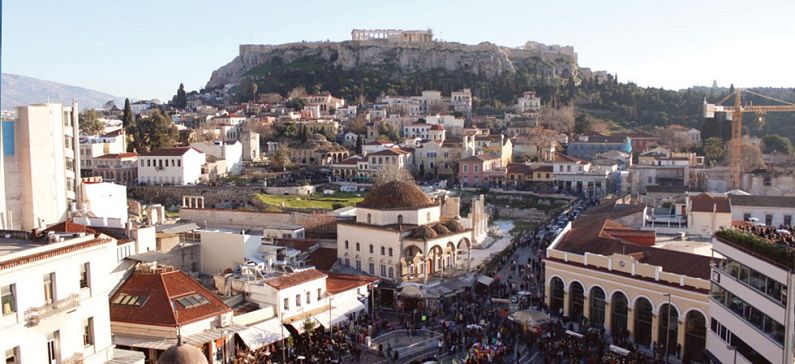
Independent: 48 hours in Athens
The English newspaper «The Independent» devotes an article to Athens, a destination that is becoming more and more popular again. «48 hours in Athens» is the title of the article and the newspaper offers accommodation and travel tips, as well as which museums and archaelogical sites should a tourist visit and of course culinary advice. It is a guide with the best tips in order to help each traveler have an amazing 48-hour trip to Athens combining culture with entertainment.
See below the article:
After years of economic gloom, the Greek capital has a buzz again. The new National Museum of Contemporary Art opens in June in a converted brewery (www.emst.gr) at the junction of Kallirois and Amvrisiou Frantzi Avenues. First up is a specially curated exhibition of its «Treasures»: 500 works across all five floors of this 1950s industrial block.
Athens airport is 32km east of the centre. The blue Metro Line 3 (oasa.gr; €8) takes 30 minutes to reach Syntagma (Constitution) Square and a couple of minutes more to Monastiraki Station in the city centre. Services stop at midnight. The inaccurately named X95 Airport Express bus runs all night, but takes a minimum of 45 minutes to reach Syntagma Square and costs €5.
There is a taxi rank outside the airport’s Arrivals with a daytime flat-rate fare of €35 to anywhere within the centre (€50 from midnight to 5am).Athens grew up around the Acropolis, a rocky outcrop in the middle of a basin ringed by bigger hills. During the Ottoman Empire the city shrank in size and importance but, after independence in 1834, the first Greek kings expanded north of the old city walls around the royal palace – now the Parliament Building on Syntagma Square.
Much of the city’s oldest housing and retail space clusters around the Acropolis in the Plaka and Monastiraki neighbourhoods. Restoration is ongoing, and these picturesque «villages» now attract a lot of tourists. The Greek National Tourism Organisation office is at 18-20 Dionysiou Areopagitou Street (00 30 210 331 0392; gnto.gr), close to the Akropoli metro station (9am–7pm weekdays, 10am–4pm at weekends).
Day one
Areios Pagos is a rock just below the Acropolis where trials for murder were held in ancient times. These days it’s a perfect place from which to gaze north across modern Athens while the Acropolis rises immediately behind you. There are steps and handrails to make sure you get a good view, safely. Down below lie the Roman and Ancient Greek market places, surrounded by trees and lawns.
Athens contains the vestiges of many civilisations, not just Periclean Greece. Start at the Roman Agora, Athens’s «new» 1st-century market place on Epaminonda (open daily 8am-3pm; entry €2) the location of which demonstrates Emperor Augustus’s preference for building on the flat ground below the Acropolis.
Turn left, into Taxiarcheon and follow the hill down past the Greek Orthodox Church of Panagia Grigoroussa, turning left into Dexippou from where you get a great view into the 2nd-century Library of Hadrian (open daily 8am-3pm, entry €2). Turn right down Arios Street where the road is flanked by shops selling Hellenic helmets and beach towels, football shirts and museum art. After taking in the monumental façade of Hadrian’s Library, ascend the steps to the 18th-century Tzisdarakis Mosque, now a museum of Greek Folk Art (open daily, except Tuesdays, from 9am-2.30pm, admission €2). The view down into Monastiriki Square shows Athens at its gaudiest, with fruit stalls and musicians adding to the throng.
Gaze down into the exposed section of the Eridanos river (which was bricked over when Hadrian was Emperor). Descend six steps to the medieval pavement level in front of the tiny brick Church of Panagia Pantanasa, which was once a women’s monastery and from which the Monastiriki area gained its name.
Head down Adrianou Street following the signs to the flea market. The further west you get towards Thiseio Station, the more eccentric the shops become, particularly in side streets such as Normanou and Philippou. At times it can seem as if the entire contents of a 1930s household have been emptied into a shop window. The market in Avissinias Square is a riot of 20th-century Athenian bric-a-brac and vintage clothing.
Day two
Sunday morning: go to church
You’re in for a long service (from 7am to 11am) at St Irinis in Eolou Street but this small church in the old flower market is a delight. Dark and tiny inside, the church feels like somewhere that generations upon generations have prayed within. St Irinis’s functioned as the city’s first cathedral until the 1840s, when money was raised to construct the new purpose-built Metropolitan Cathedral which can be found on Mitropoleos square.
In the 1950s, Athens’s ancient market-place, now known as The Ancient Agora Museum, was excavated by archaeologists from the United States. At the same time, the area was planted with indigenous trees that have grown up to create a green oasis next to Thiseio Metro station. Wander leafy paths between the reconstructed Stoa of Attalos and the remarkably undamaged Temple of Hephaestus (open 10am-3pm daily, entry €2).
Source: Independent







